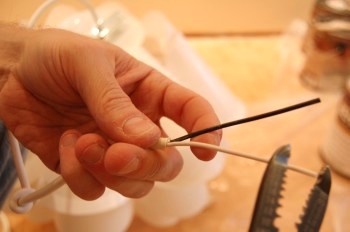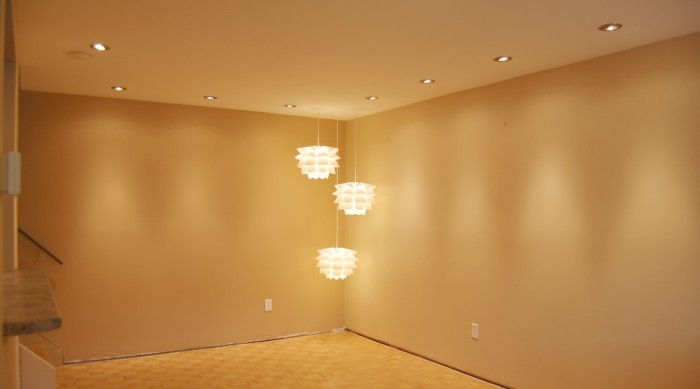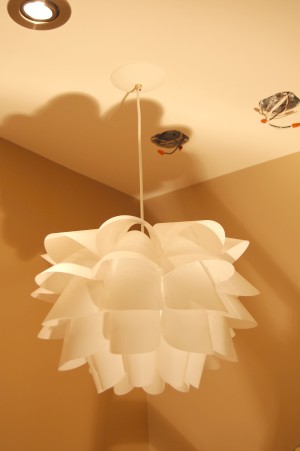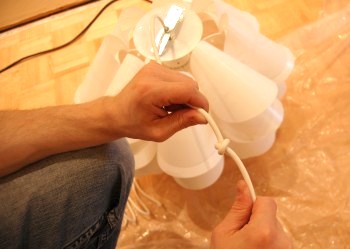Let There Be Light! Part 6: How to Convert a Plug In Light to a Pendant Light
I am inspired by lighting that echoes the forms of nature: flowers and strange undersea creature shapes are favourites of mine. For my recent living room renovation, I wanted to add a touch of prettiness to an otherwise rocky and earthen set of shapes. Ikea’s Knappa was a natural choice for me because it was floral without being too traditional. Don’t get me wrong, I love Art Nouveau, but it just wouldn’t work in the room.
The basic principle is a simple one: convert a plug-in lamp to a hard-wired one. The fun part comes when you combine multiple copies of the same shape for more drama! We have a small room and wanted to keep things simple, and Knappa is a large lamp (about 18” in diameter), so we used three of them to fill the space without overcrowding.
Before we started the actual conversion, I spent several weeks figuring out the exact placement of the lamps – when you’re making a permanent installation, it has to be right. I inserted eyehole screws into the ceiling, tied the lamps in place, and repositioned as needed until I got the right effect. The important part is to make sure you write down the exact position of each lamp in the ceiling (relative to each wall), so you can recreate the correct position. You also need to make sure you record the right cord length for each light. Our renovation included the removal of the ceiling and the installation of new circuits and octagon boxes for the lights, so we could achieve an effect we loved, but you can change any ceiling-mounted light for a Knappa.
A special safety note: electricity can be very dangerous. Please ensure that you cut the power to the fixture before you touch it, and make sure everyone with access to the circuit panel knows that the power is cut because you’re working.
Here’s how we converted each of the Knappas into hardwired lights.
Materials
Tools: ladder, wire strippers, wire cutters, utility knife, screw driver (whichever one matches the screws in the fixture cover -usually Robertson (Can), Phillips(US)
Parts: Knappa lamp, anti-oxidant wire paste, 2 wire connection caps, fixture cover kit (cover, threaded bolt, supporting cross-piece), or use the existing ceiling fixture parts. Optional: paint matching your ceiling colour.
Steps
Part 1: Preparing the Ceiling Fixture
Please don’t forget – the power to the fixture must be off for all steps going forward! If you’re working on this in the evening, you may need light coming from another circuit (that’s what we used). If all the lights in the room are on one circuit, you’ll have to work by daylight.
- If you don’t want to reuse the old light, cut the cord in the old fixture and remove using the wire cutters.
- Unscrew the fixture cover from the ceiling and put aside. Unscrew the threaded bolt from the fixture cross piece. Remove the cross piece using the screw driver – don’t lose any of these parts!
- You now need to separate the wires from the circuit from the wires for the light. Untwist them if possible – you can cut these if you need to, but try to preserve as much of the circuit wire as you can.
- You will now have an empty octagon box with the room’s circuit wires hanging out.
- If desired, paint your fixture covers the same colour as the ceiling and allow them to dry. You could also choose a contrasting colour, but it can be disconcerting when the fixture cover almost-but-not-quite-matches the ceiling, so I do recommend painting it one way or the other.
Part 2: Preparing the Knappa
 Measure out how much of the Knappa cord you wish to retain, and add 8 inches. Cut the cord using the wire cutters.
Measure out how much of the Knappa cord you wish to retain, and add 8 inches. Cut the cord using the wire cutters.- Using the utility knife, carefully cut a shallow slit into the cord, and press open. You are looking for the two conducting wires within the cord, and it is vital that you do not cut their shielding. If you do, you need to start over with a new part of the cord, as open shielding is a fire hazard.
- Once you find the two conductive cords, you can complete the slit in the cord all the way to the cut end.
- Cut around the base of the cord, and remove the 8 inches of the cord housing, leaving the 2 conductive wires exposed.
- With the wire strippers, remove the last inch of shielding from each of the conductive wires. Twist these wires between your thumb and index finger, so that the tiny wires spiral tightly together.
Part 3: Connecting the Knappa to the Ceiling
-
You will need to thread the ceiling fixture parts onto the Knappa cord before you connect the wires. Put the fixture cover on first (with convex side of the dome facing towards the Knappa), then the threaded bolt, then the supporting cross-piece.
- Tie a knot at the end of the Knappa cord, right at the base of where you removed the outer cord sheathing. This will support the weight of the Knappa – it is light, but you don’t want the weight supported by the connection of the wires for fire safety reasons.
- Climb up the ladder, carrying your Knappa with you. If the cord is long, you may want to have someone hold the Knappa for you, as you don’t want it bumping around and getting damaged.
- Twist the exposed ends of the ceiling circuit wires and the Knappa wires together: match black to black, and white to white.
-
If connecting to aluminum wires, apply a generous blob of anti-oxidant paste to each of the 2 wire connections. This is a precaution against fires, as aluminum wiring especially will oxidize over time, resisting current flow and heating the wire. The paste is messy, so try not to let it get onto your hands.
- Screw wiring caps onto each of the wiring connections.
- Tuck the connections into the octagon box.
- Screw in the supporting cross piece into each side of the octagon box.
- Screw the threaded bolt into the supporting cross-piece.
- Screw the fixture cover onto the threaded bolt. You may need to remove the fixture cover and adjust the depth of the threaded bolt into the supporting cross piece a few times. You want enough of the threaded bolt to protrude from the supporting cross piece to support the fixture cover, but not so much that there is a gap between the fixture cover and the ceiling
- You can now return power to the circuit.
- Switch on the light and enjoy!
Repeat the steps for your additional Knappas if required.
Special Knappa Modification Note
Some people may notice that I have changed the shape of the Knappas themselves (very subtly). If you assemble them according to the instructions, the top row of petals sticks up too much for my taste. There are two problems: they don’t follow the angle of the petals below, and also, if you sit below them there is too much glare off the inside of the top row.
To fix this, I left the top row of petals partially unpinned to the frame, so that each petal could pivot. To hold the petals at the right height (so they don’t flop completely) I used thread through the empty holes, pulled the thread tight and knotted.

3 Knappa plug in lights converted to pendant lights. You can see we still have some work to do adding baseboards!
Next Post: Baseboards and other finishing touches (this is it!).
By Jennifer Priest
Follow me on Google +




the easiest way I found was to buy a 15$ pendant light kit at lowes (or home depot) - you…